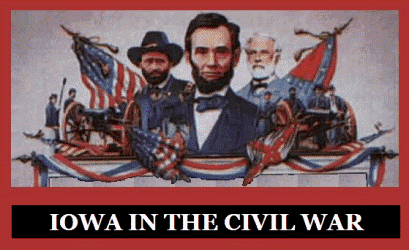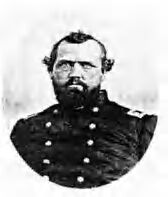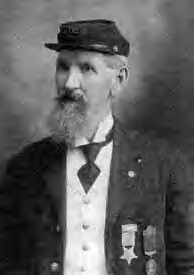

During the Civil War, Dr. Benjamin Franklin STEPHENSON, pictured at right, of Springfield, Illinois served his two-year enlistment as a surgeon of the Fourteenth Illinois Infantry. He is credited with the conception and development of a post-war organization [G.A.R.] of Union veterans, based partly on military tradition and partly on the traditions of Freemasonry. The first Grand Army of the Republic post was organized and chartered on April 6, 1866 in Decatur, Illinois with twelve charter members. When an Illinois state convention was held on July 12, 1866, thirty-nine posts had been organized and chartered. With rapid interest in other adjoining states, ten states and the District of Columbia were represented at the first national encampment on November 20, 1866, which was held at Indianapolis, Indiana.
During the peak year of the G.A.R. organization in 1890, membership numbered approximately 490,000 veterans. There were over 7,000 posts ranging in size from a couple of dozen members in small town posts to more than a thousand members in posts located in major American cities. Virtually every prominent Veteran held a membership in a G.A.R. post along with five Presidents of the United States - Ulysses S. GRANT (1869-1877), Rutherford B. HAYES (1877-1881), James A. GARFIELD (1881-1881), Benjamin HARRISON (1889-1893), and William McKINLEY (1897-1901).
In 1868, General Order #11 of the G.A.R. called for May 30th to be designated as "Decoration Day," a day of memorial for fallen soldiers. The wife of General John A. LOGAN, Commander-in-Chief of the G.A.R., had been moved by the women in Virginia decorating the graves of fallen Confederate soldiers. Taking his wife's observations [perhaps her suggestions?], General LOGAN requested that members of all G.A.R. posts to decorate the graves of their fallen comrades with flowers on May 30, 1868. "Decoration Day" eventually evolved into today's Nationally observed Memorial Day.
During its time, the organization wielded considerable political clout. Between the years 1868 to 1908, no Republicans were nominated to the United States Presidency without endorsement from the G.A.R. Due to influence from the G.A.R. retirement homes were established for soldiers, legislation for veteran pensions were passed, and Old Soldier Homes were established. These early activities later evolved into the United States Department of Veterans Affairs.
In 1862 President Abraham LINCOLN approved a bill which granted pensions for soldiers who were premanently disabled during their military service. An act which liberalized the condition of veteran pensions was passed in 1879. G.A.R. sponsored pension bills decided the fate of presidential elections with Grover CLEVELAND losing his re-electing in 1888 due to his veto of a Dependent Pension Bill, and Benjamin HARRISON's presidential win with his commitment to support soldier pension legislation. The Disability Pension Act of 1890 expanded the scope of veteran's pensions to include every veteran who had served a minimum of ninety-days military service and some type of disability not necessarily incurred as a result of War.
Many of the G.A.R.'s activities helped to reunite a fractured divided nation, with members spending considerable time in soliciting funds for monuments and memorials; embracing and encouraging the preservation of Civil War sites, relics, and historical documents; donations of battle-stained flags to local and state museums; and encouraging the placement of cannons and battlefield-pieces in courthouse lawns and local parks.
There was a National Encampment every year from 1866 to 1949. At the final encampment, the few remaining surviving G.A.R. members voted to retain the existing officer in place until the dissolution of the organization. Theodore PENLAND of Oregon retained his position as the G.A.R. Commander-in-Chief until his death. The last surviving member was Albert WOOLSON who died in 1956. With his death, the G.A.R. records were donated to the Library of Congress while the badges, flags, and offical seal went to the Smithsonian Institute. Iowa's G.A.R. documents and assorted materials are housed at the University of Iowa's Library Collections in Iowa City.
 The G.A.R. uniform, as
pictured at right, consisted of a double-brested, dark blue coat
with bronze button and a black wide-brimmed felt hat with a gold
wreath insignia and cord, although many G.A.R. members wore hats
similar to their Army-issued hats worn during their military
service. Lapel insignias were a bronze star badge which was attached
to a small chiffon flag. The star depicted a soldier and sailor
clasping hands in from of a figure of Liberty. The men referred to
one another as "Comrade."
The G.A.R. uniform, as
pictured at right, consisted of a double-brested, dark blue coat
with bronze button and a black wide-brimmed felt hat with a gold
wreath insignia and cord, although many G.A.R. members wore hats
similar to their Army-issued hats worn during their military
service. Lapel insignias were a bronze star badge which was attached
to a small chiffon flag. The star depicted a soldier and sailor
clasping hands in from of a figure of Liberty. The men referred to
one another as "Comrade."
The Department of Iowa G.A.R. was organized September 26, 1866, Davenport, Iowa, with J. B. LOCKE elected Commander. At this time, Iowa had 45 posts and approximately 350 members. Membership grew to 408 posts and 19,400 members. Iowa G.A.R. encampments were held annually in April.
The last surviving Civil War Veteran in the State of Iowa was James P. MARTIN, who died in a little frame house he shared with his widowed daughter Mrs. Elise HILL in Sutherland, Iowa, on September 20, 1949, at the age of 101 years. Mr. MARTIN vividly remembered carrying the news of President LINCOLN's assissination to Fort Lyon, Virginia, but his participation in the Battle of Gettysburg and other skirmishes had faded from his memory during his last years. Mr. MARTIN was one of the last G.A.R. members in the United States.
James P. MARTIN was born November 10, 1847, in Scotland and came to the United States at the age of five with his family. They settled in Wisconsin. He was sixteen-years-old when he enlisted from his residence at Mineral Point, Wisconsin, and served in the 1st Wisconsin Heavy Artillery. Four of his brothers also served the State of Wisconsin during the Civil War. All five brothers survived to come home after the War.
Mr. MARTIN, his wife, Mary Elizabeth BRADY, formerly of LeRoy, Kansas, and his seven children moved to Iowa in 1886, settling on a farm located 5 miles east of Sutherland, Iowa. Mrs. MARTIN died in 1916. Mr. MARTIN lived with his widowed daughter since 1936.
Mr. MARTIN was named Iowa State Commander-in- Chief of the G.A.R. Department of Iowa in 1947, suceeding John M. GRUDGEL who had died in Shenandoah on March 22, 1947 at the age of 99 years. On June 20, 1949 Ebenezer G. McMURRAY of Iowa City died at the age of 102, leaving Mr. MARTIN the only surviving Civil War Veteran residing in Iowa.
Mr. MARTIN marched in every Memorial Day parade until 1946, his last public appearance. He was still driving his car at age 94 and continued to work in his garden until he was 97. Ill health prevented him from attending the Last Encampment of the Grand Army of the Republic in Indianapolis, Indiana, in August of 1949.
When the end came, Mr. MARTIN was attended by his daughter Mrs. Hill and the family doctor at his bedside. Mr. MARTIN left six surviving children: Mrs. HILL and Mrs. Mary A. THEISEN, both of Sutherland, Iowa; Clyde MARTIN of Calument, Iowa; William R. MARTIN of Kalispell, Montana; James B. MARTIN of Hoquiam, Washington, and Mrs. R. E. LAMPMAN of Merced Falls, California; 28 grandchildren; 51 great-grandchildren, and two great-great-grandchildren. Mr. MARTIN was interred with full military honors and Masonic Services. Attending the funeral were Miss Amy NOLL of Des Moines, Secretary of the State of Iowa Grand Army of the Republic, Governor William S. BEARDSLEY, and Brigade General Charles H. GRAH. The Allied Orders of the Grand Army of the Republic [Daughters of Union Veterans of the Civil War, Sons of Union Veterans of the Civil War, Woman's Relief Corps, Ladies of the Grand Army of the Republic, and Auxiliary of the Sons of Union Veterans of the Civil War] placed a monument in memory of James P. MARTIN in the town of Sutherland, Iowa.
~Compiled by Sharon R. Becker, March of 2009
Several G.A.R. auxiliary organizations were established to help carry on the work which the organization had begun. The Woman's Relief Corps was nationally organized in 1883; the Ladies of the Grand Army of the Republic was established in 1896; and the Sons of Union Veterans of the Civil War was founded in 1881.
The United Confederate Veterans was founded in New Orleans in 1889, partly as a campaign to perserve Chickamauga and Chattanooga National Military Parks. Sons of Confederate Veterans was established in Richmond, Virginia in 1896.
Daughters of Union Veterans of the Civil War, Des Moines 1861-1865
7 Tents organized September 8, 1915 at Burlington, Chariton, Des Moines, Mason City, Mt. Pleasant, Ottumwa, and Waterloo, Iowa.
Kinsman Woman's Relief Corps No. 24, Des Moines Iowa
Ladies of the Grand Army of the Republic, Dubuque, Iowa
Son of Union Veterans of the Civil War
Woman's Relief Corps, Davenport, Iowa 1886-1932
Woman's Relief Corps, Des Moines, Iowa 1884-1934
~Compiled by Sharon R. Becker, March of 2009